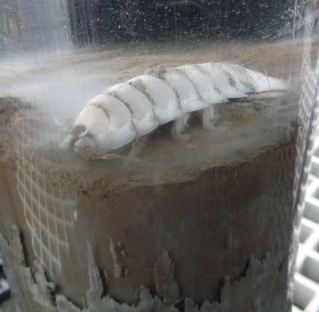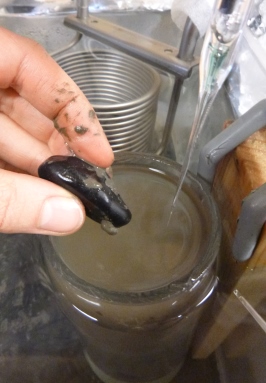Sediment zoo reloaded
 My Spanish colleague to our Russian ecologist: “This is like what we put in the Paella, no?” – “This is cockroach of the ocean!”  A stone? Yes. This might seem rather boring to some of you, but I will try to explain why it is pretty cool to discover a stone in the sediment here. What kind of material do you expect to find on the bottom of the sea? I would guess many people imagine something similar to a sandy beach with some stones or even rocks, right? But the material we sample here is actually really fine mud, very soft, sticky clay. And that makes sense when you think about it. On a beach the waves provide a lot of energy to push around heavy things like stones. But under several dozens or even hundreds of meters of water, there are no waves and thus very little energy to move stuff. Only tiny, light particles are transported down here. The stone I found in my sediment core must therefore have travelled all the way from land to our sampling location while it was trapped in ice. Since they are released when the ice melts and thereby dropped onto the sea floor, often far from their origin, these stones are commonly called “drop stones” or “ice raft debris”. There are two possible scenarios for drop stones: either they come from underneath a glacier and are then enclosed in an iceberg (by definition formed on land from freshwater) or they lie on the shore and get trapped when the sea water freezes and eventually forms ice sheets. The stone I found is rounded on the edges, which suggests that it had been smoothed in water before it was trapped. It was buried a few centimeters below the sediment surface; I was just lucky not to hit it with my fragile electrode (on the right side of the picture) when I was measuring the oxygen concentrations in that core! So far, this has been the first and only drop stone we found, not surprisingly at one of the two stations where we had land in sight: Bennett Island (see Emma’s posts and pictures). A stone? Yes. This might seem rather boring to some of you, but I will try to explain why it is pretty cool to discover a stone in the sediment here. What kind of material do you expect to find on the bottom of the sea? I would guess many people imagine something similar to a sandy beach with some stones or even rocks, right? But the material we sample here is actually really fine mud, very soft, sticky clay. And that makes sense when you think about it. On a beach the waves provide a lot of energy to push around heavy things like stones. But under several dozens or even hundreds of meters of water, there are no waves and thus very little energy to move stuff. Only tiny, light particles are transported down here. The stone I found in my sediment core must therefore have travelled all the way from land to our sampling location while it was trapped in ice. Since they are released when the ice melts and thereby dropped onto the sea floor, often far from their origin, these stones are commonly called “drop stones” or “ice raft debris”. There are two possible scenarios for drop stones: either they come from underneath a glacier and are then enclosed in an iceberg (by definition formed on land from freshwater) or they lie on the shore and get trapped when the sea water freezes and eventually forms ice sheets. The stone I found is rounded on the edges, which suggests that it had been smoothed in water before it was trapped. It was buried a few centimeters below the sediment surface; I was just lucky not to hit it with my fragile electrode (on the right side of the picture) when I was measuring the oxygen concentrations in that core! So far, this has been the first and only drop stone we found, not surprisingly at one of the two stations where we had land in sight: Bennett Island (see Emma’s posts and pictures).
|
| by Lisa Bröder |














